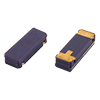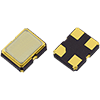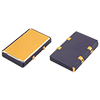Understanding Frequency Tolerance and Stability in Quartz Crystals and Oscillators
26 Oct 2023
KATIEJENKIN@GOLLEDGE.COM
You know that handy smartphone in your pocket, the clock that tells the time, and the GPS guiding you to your destination? They all have one thing in common. The use of quartz crystals and oscillators .
While these parts may sound complicated, they play an integral and role in our modern world of technology.
In this article, we're going to examine both quartz crystals and oscillators further to find out exactly how they work and their growing importance in our society. We’ll also dive into the crucial concepts of frequency tolerance, stability, and how they shape the gadgets we can't seem to live without these days.
Frequency tolerance definition
Okay, let's start with the basics. Frequency tolerance refers to how much a quartz crystal or oscillator's output frequency can deviate from its ideal or nominal value.
In simpler terms, it's like having a favourite radio station, but sometimes the signal gets a bit fuzzy, causing the music to sound off-tune.
The frequency tolerance is usually expressed in parts per million (ppm). For instance, if a crystal has a tolerance of ±10 ppm, it means the actual output frequency can vary by up to 10 parts in a million from the desired frequency.
Imagine tuning into your favourite radio station, and you expect to hear your favourite song at exactly 3:00 PM, but it might start a few seconds early or late. That's frequency tolerance in action.
What is the difference between frequency tolerance and frequency stability?
The importance of stability in oscillators
Now that we have a grasp on tolerance, let's tackle stability.
Think of stability as the conductor in an orchestra ensuring that all the musicians are in tune and that the music flows seamlessly. In the world of quartz crystals and oscillators, stability is paramount.
Stability, in this context, refers to how consistent the output frequency of a crystal or oscillator remains, regardless of time, temperature, and voltage changes. Why does this matter? Well, imagine you're relying on a device to send crucial information to a satellite, and its frequency keeps wobbling. That's a disaster.
In essence, frequency stability ensures that your wireless signal is clear, your data is transmitted accurately, and your GPS doesn't lead you astray. It's the key to seamless communication and precise timekeeping in the tech world.
Factors affecting frequency stability
Frequency stability is the cornerstone of reliable electronic devices, ensuring that your GPS navigation stays on point, your smartphone communicates seamlessly, and your data transmission remains error-free.
However, this stability isn't solely governed by inherent qualities. Instead, it is influenced by a variety of essential factors, such as:
1. Temperature: Quartz crystals are temperature-sensitive. Watch crystals have a unique temperature response, with their optimal performance occurring at around 25°C. As the temperature departs from this point, the crystal's frequency stability starts to diminish, and beyond this point, it starts to experience an increase in significant frequency shifts as the temperature deviates in either direction. For instance, you might observe that your timekeeping devices, like watches or clocks, run slightly slower in warmer weather and slower in colder conditions. This effect can be inconvenient, particularly in precision applications.
However, oscillators with integrated temperature compensation mechanisms are engineered to counteract this influence, ensuring consistent frequency output even as the temperature fluctuates. These are known as TCXOs (temperature-controlled oscillators).
2. Voltage: The power supply voltage plays an important role in determining the output frequency of crystal oscillators. Changes in supply voltage can disrupt the regularity of the output frequency of an oscillator.
Imagine listening to a song with unpredictable volume changes – it's an experience that's far from enjoyable, right? In electronics, these voltage fluctuations can lead to erratic frequencies, potentially affecting the performance of devices. To maintain a steady output, voltage regulators are employed to ensure that the voltage remains within the desired range. This helps in keeping the frequency output of the oscillator stable and reliable.
You can purchase high quality voltage-controlled oscillators (VCXOs) right here from Golledge.
3. Aging: Much like any other mechanical or electronic component, quartz crystals are not immune to the effects of time. As years pass, some parts of these crystals may experience subtle changes, resulting in shifts in frequency.
These age-induced variations can impact the accuracy of the crystal oscillator. In response, manufacturers and engineers employ precise design and manufacturing practices to mitigate the effects of aging as far as is possible. This approach ensures that the oscillator remains consistent and reliable over an extended period, maintaining its frequency accuracy.
4. Output Load (oscillators): The load impedance is an external component that directly influences the stability of the quartz crystal oscillator.
5. Load Capacitance (crystals): If the parallel resonance of a crystal is used the load capacitance is essential in determining the resonance frequency of the crystal. The interaction between the external load capacitance and the inherent motional parameters of the crystal forms a resonant circuit that vibrates at the desired frequency when excited by an oscillator circuit.
Fine-tuning the load capacitance allows engineers to adjust the performance of the crystal oscillator, optimizing its stability and accuracy. This precise adjustment ensures that the oscillator operates in precise harmony with other components in the circuit, providing a consistent and reliable frequency output. Designers should consider the tolerance of the load capacitors when calculating the overall accuracy of the oscillator.
In essence, these factors significantly impact the performance of quartz crystals and oscillators. Understanding how temperature, voltage, aging, and load capacitance influence frequency stability is critical in designing and selecting components for applications where precision and reliability are crucial.
Ways to improve tolerance and stability
So, how do you ensure that your quartz crystals and oscillators hit the right notes when it comes to frequency tolerance and stability?
- Select High Quality Components: It all starts with choosing the right quartz crystals and oscillators. Reputable manufacturers like Golledge Electronics offer high-quality components that are designed for optimal performance.
- Temperature Compensation: Using oscillators with temperature compensation mechanisms, like TCXOs (Temperature-Compensated Crystal Oscillators) and OCXOs (Oven- Controlled Crystal Oscillators), can greatly enhance stability, even in extreme temperature conditions.
- Voltage Regulation: Ensure a stable power supply with voltage regulation, so your devices don't dance to the beat of power fluctuations. The role of voltage regulation is ensuring that the voltage remains constant and within the desired range. This not only keeps your quartz crystal oscillator's output frequency stable but also prevents any unwanted surprises.
- Regular Calibration: Periodic calibration and adjustments can help maintain long-term stability, especially in critical applications like telecommunications and navigation systems. For these applications, calibration is not a luxury but a necessity. Regular calibration and adjustments ensure that these critical systems continue to operate with the highest degree of accuracy and reliability, even in the face of challenging conditions.
- Consult the Experts: When in doubt, seek advice from experts like Golledge Electronics. They have the knowledge and experience to guide you in selecting the right components for your specific needs.
Expert help with your frequency stability needs from Golledge
So, there you have it – the lowdown on frequency tolerance and stability in quartz crystals and oscillators. These tiny components, often overlooked, are the unsung heroes behind the technology that keeps our modern lives running smoothly.
To ensure your devices perform at their best, from GPS systems to wireless communication, it's essential to understand and invest in components that offer superior frequency tolerance and stability. So, next time you're enjoying a crystal-clear wireless call or receiving accurate GPS directions, you'll know the secret behind it all – the reliable quartz crystals and oscillators that keep things in sync.
For the best in frequency control products and unwavering commitment to exceeding your needs, look no further. At Golledge Electronics, we're the UK's leading supplier, serving the global electronics industry with top-tier solutions. Our philosophy is simple: your requirements come first. We're dedicated to delivering the utmost quality and consistency in all our products and services.
Ready to elevate your tech game? Get in touch with Golledge Electronics today.




